I am currently leading, together with Metropolitan Methodios of the Greek Orthodox Metropolis of Boston, a joint pilgrimage to Rome, Constantinople and Saint Petersburg. My blog gives me the opportunity to share the pilgrimage with Catholics from Boston and beyond who were unable to accompany us.
Before I left on the trip, we had a wonderful assembly of our clergy last Friday. About 450 were able to be with us. It was a time to pray and reflect together over our experiences as a diocese in the last few years. Bishop Robert Hennessey gave a very beautiful talk to open the meeting, which I think set the tone. Then there were group discussions, a presentation regarding the well-being of our priests, and I gave the closing address. We ended with a dinner and had a beautiful vespers service. Our priests worked very hard at preparing the day, and all that work paid off.
The event was an opportunity for us to come together and try to begin to prepare for the challenges ahead as we embark on our bicentennial — a new century in the life of the church of Boston. I think in general the reaction to the day was very positive, and I think everyone found it was a way in which we were able to deepen our commitment to the Lord and to one another in His ministry.
We will have another assembly in November, which will be a spiritual meeting in preparation for the evangelization program that is going to be a part of the celebration of the 200th anniversary of the archdiocese.
– – –
A couple of weeks ago, Sept. 9, I celebrated the Mass for the Centennial of St. Louis de France School in Lowell. Although children come from different parishes in the area, the school is officially associated with St. Marguerite d’Youville parish in Dracut and the pastor Father Robert Connors is very supportive of the school.
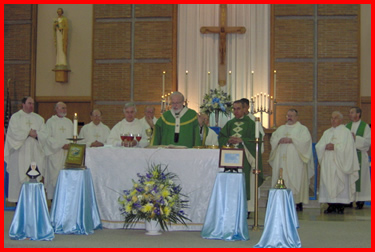
Fr. Bob Connors and other area priests concelebrated
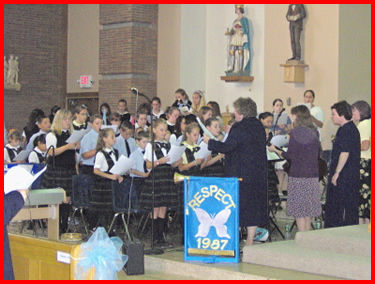
The school choir, led by Sr. Jeanne Frechette, sang very nicely
The School has been staffed by the Sisters of the Assumption of Nicolet since its founding and there are still many sisters in the local community and six working full time in the school.
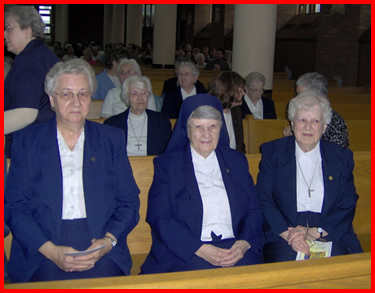
Sr. Estelle Dube, Sr. Bernadette Lemoine and Sr. Lucille Mercier
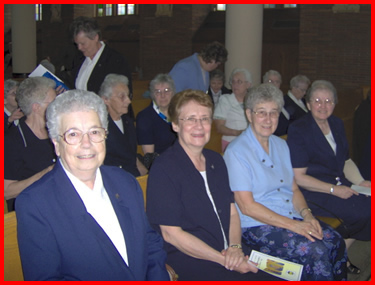
Sr. Irene Prud’homme, Sr. Lucille Leclair,
Sr. Lucille Pleau and Sr. Rita St.Onge
Sr. Irene Martineau, the school principal is doing a very good job managing the school.
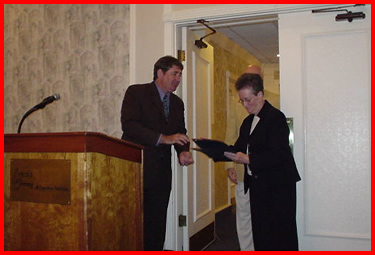
from Mayor of Lowell, William F. Martin at the Centennial banquet
The school was originally founded to meet the needs of the local French Canadian immigrant families — who worked mostly in the local mills — and now serves a wide range of immigrant populations from many countries.
– – –
The pilgrimage left Boston on Sunday evening. Pilgrims spent Monday settling into our accommodations in Rome.
Here in Rome our presence is greeted very enthusiastically. People see this as a wonderful initiative and an important way of bringing our people together in a very practical way to have them pray together, be pilgrims together and learn more about each others’ Church. It’s a wonderful experience.
On Tuesday, the pilgrims spent the day visiting the Vatican.

Arriving to the Vatican

Greeting the pilgrims

St. Peter, brother of St. Andrew, welcomed the pilgrims
In the morning, they went on what we call the “scavi” tour. They visited the excavations of a necropolis underneath the basilica where St. Peter is actually buried. It is always a very moving experience.
Photos are not allowed inside, but I thought you would like to take a glimpse of the necropolis, so I am posting a few photos of the site from Catholic News Service.
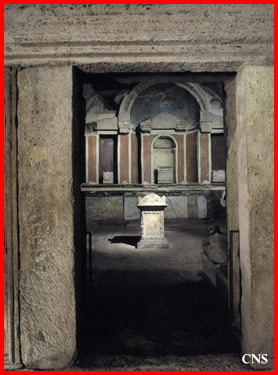
Mausoleum of Caetennius Antigonus was one of the first discoveries
during the 1940s excavations
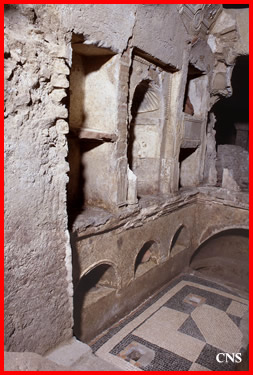
Niches for cremated remains are seen in a tomb area. The necropolis includes
the tombs of rich families, middle-class families and even some slaves.

A mosaic floor depicting Dionysius
and other pagan themes is seen in a family tomb
There are narrow passageways leading down there and groups can only go down 10 at a time. But visiting St. Peter’s tomb really is, to me, one of the most spiritually uplifting things about visiting. Peter is the rock on which the Church is built and on which St. Peter’s Basilica is built literally because his tomb is directly under the high altar of the basilica. For the Orthodox as well as the Catholics, visiting the tomb of St. Peter the Apostle is a very meaningful spiritual event.

A light rain fell while the pilgrims toured St. Peter’s square
The pilgrims also visited the Vatican Museums that include the Sistine Chapel.

A group photo

At the Vatican museums


Sister Mary Christa Nutt, of the Sisters of Mercy of Alma, Michigan, very graciously gave a tour of the basilica to the Boston pilgrims.

Sister Mary Christa Nutt greets some of the pilgrims


Inside St. Peter’s Basilica

In the meantime, Metropolitan Methodios and I, joined by a representation of five Catholics and five Greek Orthodox pilgrims, met with Bishop Brian Farrell, Secretary of the Pontifical Council for Promoting Christian Unity.
He welcomed us very warmly and was very gracious in explaining the work of his congregation, particularly in the relationships between the Orthodox and Catholics going back to the historical meetings between the Ecumenical Patriarch Athenagoras and Pope Paul VI in the mid 1960s.
In fact, they took this picture of us in front of the icon depicting Peter and Andrew that Patriarch Athenagoras gave to Paul VI.

Bishop Brian Farrell welcomed us
That meeting was really a sort of big turning point in the relations between Catholics and Orthodox. Paul VI went and visited Athenagoras. Forty years later the dialogue continues focused on the role of the papacy and the role of the synods in the Church. At the Pontifical Council they were all very enthused by the concept of a joint pilgrimage.
Then, in the afternoon we went to my titular church, Santa Maria della Vittoria, where we were joined by Bishops Bob Hennessey and John Dooher, who are here taking a course for the newly appointed bishops here in Rome.


We were also joined by Father Arthur Kennedy, the new rector at St. John’s Seminary, Father Bob Oliver, a professor at St. John’s and Msgr. Bob Deeley, a Boston priest working at the Congregation for the Doctrine of the Faith.



In the morning on Wednesday, we had a papal audience at which time we were able to greet Pope Benedict personally.



The Holy Father told me how pleased he was
that in the United States we are working so hard
to promote unity among Catholics and Orthodox.
Then, Metropolitan Methodios presented the Holy Father with a beautiful silver and gold cross. It was a hand cross that Greek bishops use to give blessings.

In the afternoon, we visited the Church of St. Theodore, the church John Paul II gave to the Greek Orthodox here in Rome.

Greeting the pilgrims as they enter St. Theodore

Greeting Regina Lang, our youngest pilgrim

St. Theodore is right at the edge of the Roman Forum.

A view of the Roman Forum from St. Theodore
It is a magnificent, very ancient church with mosaics from the fourth century and is now a parish church for the Greek Orthodox.

Following the Greek Orthodox custom,
pilgrims lit candles as they entered the church
We prayed vespers there and the pastor, Archimandrite Simeon, received us very, very graciously. He gave us a tour and explained to us the different aspects of this lovely church.

Archimandrite Simeon, welcomed us



It is a beautiful Church



From there, we went to the Basilica of St. Mary Major.

Pilgrims entering St. Mary Major
There we prayed before the icon of Our Lady that was, according to tradition, painted by St. Luke.



Then we also visited the major relics of the church, which are under the high altar. They are actually part of the crib from Bethlehem that St. Helena, the mother of the emperor Constantine, brought to Rome. When she brought the relics of the true cross, she also brought relics of the manger, and they are venerated at St. Mary Major’s, which is the most important Marian church in Rome.

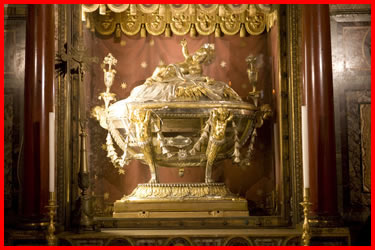
It is the church where Cardinal Bernard Law is the archpriest. Cardinal Law was not there for our visit, but he very graciously made guides available and had the bells rung when we arrived. We were made to feel very welcome by the canons of the church and given a very good explanation by Father Steven of the Heralds of the Gospel. Father Steven is an American in Rome who belongs to this group, which is mostly present in Brazil and Spain.

This little lamp was a gift of an Orthodox patriarch
to burn over the relic of the nativity


A group photo with the canons outside the Basilica
Next, we went to the Basilica of St. Paul’s Outside the Walls, and that was also an extremely moving experience.

Vito Nicastro (center) from our Office of Ecumenical affairs
walks towards St. Paul Basilica with
Father John O’Donnell (right) and other pilgrims

St. Paul
Abbot Edmund Power, who is a British monk, met us at the door, prayed over the pilgrims and sprinkled us with holy water. Then, he gave us a very long explanation of the history of the basilica, leading us at the end to the tomb where St. Paul is buried.
He presented us with the chains of St. Paul, and all of the pilgrims went up and kissed the chains. It was very moving.

the chains of St. Paul

Abbot Edmund Power presented pilgrims
with the chains of St. Paul


Father Peter Beaulieu, a priest
of the Archdiocese of Worcester, kisses the chains
Those chains have been in the basilica from the 300s. The priest said that St. John Chrysostom wrote that he wanted to go to Rome to venerate the chains of St. Paul in the basilica of St. Paul Outside the Walls. He said that John Chrysostom never made it there, but the Greek Orthodox who were there were doing just that in the name of this great father of the Eastern Church.

The chains are kept in this reliquary room with other relics

The reliquary of the chains of St. Paul.
The abbot took the chains out so we could kiss them
Then we had Mass and Bishop Dooher preached. We were also joined by Father Kennedy and Msgr. Deeley.

Celebrating Mass over the tomb of St. Paul

On Thursday morning, we flew to Istanbul — the old Constantinople — for the second leg of the pilgrimage. There we were expected to meet the Patriarch of Constantinople, Bartholomew I. On next week’s blog I will continue my report on this wonderful pilgrimage.
For the photo of the week I have chosen this historical photo of the first meeting between Paul VI and Orthodox Ecumenical Patriarch Athenagoras of Constantinople during the Pontiff’s 1964 trip to the Holy Land.

